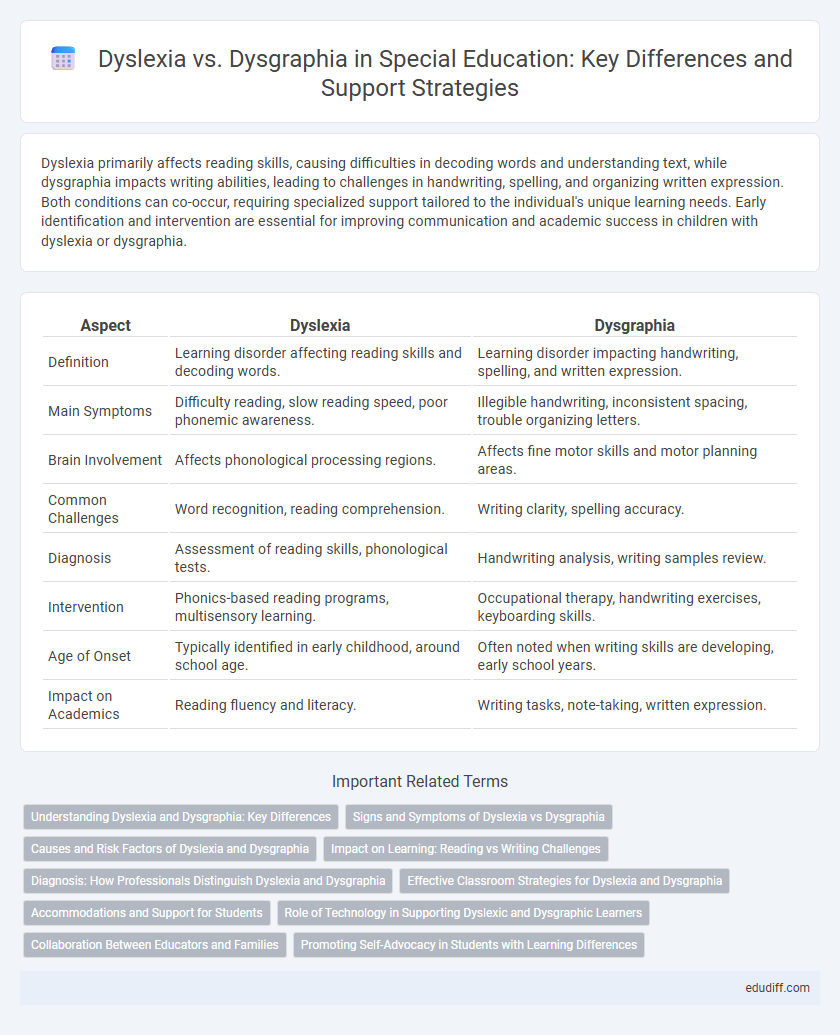Dyslexia primarily affects reading skills, causing difficulties in decoding words and understanding text, while dysgraphia impacts writing abilities, leading to challenges in handwriting, spelling, and organizing written expression. Both conditions can co-occur, requiring specialized support tailored to the individual's unique learning needs. Early identification and intervention are essential for improving communication and academic success in children with dyslexia or dysgraphia.
Table of Comparison
| Aspect | Dyslexia | Dysgraphia |
|---|---|---|
| Definition | Learning disorder affecting reading skills and decoding words. | Learning disorder impacting handwriting, spelling, and written expression. |
| Main Symptoms | Difficulty reading, slow reading speed, poor phonemic awareness. | Illegible handwriting, inconsistent spacing, trouble organizing letters. |
| Brain Involvement | Affects phonological processing regions. | Affects fine motor skills and motor planning areas. |
| Common Challenges | Word recognition, reading comprehension. | Writing clarity, spelling accuracy. |
| Diagnosis | Assessment of reading skills, phonological tests. | Handwriting analysis, writing samples review. |
| Intervention | Phonics-based reading programs, multisensory learning. | Occupational therapy, handwriting exercises, keyboarding skills. |
| Age of Onset | Typically identified in early childhood, around school age. | Often noted when writing skills are developing, early school years. |
| Impact on Academics | Reading fluency and literacy. | Writing tasks, note-taking, written expression. |
Understanding Dyslexia and Dysgraphia: Key Differences
Dyslexia primarily affects reading skills, causing difficulties with word recognition, decoding, and spelling, while dysgraphia impacts writing abilities, including handwriting, spelling, and organizing ideas on paper. Neurodevelopmental differences in dyslexia are linked to phonological processing deficits, whereas dysgraphia involves fine motor skill challenges and difficulties in letter formation. Understanding these distinct characteristics is crucial for developing targeted interventions and specialized educational strategies for individuals with each disorder.
Signs and Symptoms of Dyslexia vs Dysgraphia
Dyslexia primarily manifests through difficulties in reading, such as slow reading speed, trouble decoding words, and frequent spelling errors, while dysgraphia is characterized by poor handwriting, inconsistent letter sizing, and problems with spelling and organizing written work. Children with dyslexia often struggle with phonological processing, making it hard to connect sounds with letters, whereas those with dysgraphia experience impaired fine motor skills and difficulty forming letters smoothly. Signs of dyslexia include reversing letters or confusing similar-looking words, whereas dysgraphia symptoms involve cramped handwriting, uneven spacing, and frequent erasures or cross-outs.
Causes and Risk Factors of Dyslexia and Dysgraphia
Dyslexia primarily results from genetic factors affecting brain regions responsible for phonological processing, with risk factors including family history and premature birth. Dysgraphia stems from neurological issues impacting fine motor skills and language processing areas, often linked to developmental delays, brain injury, or conditions like ADHD. Environmental influences such as limited early literacy exposure can exacerbate symptoms in both dyslexia and dysgraphia.
Impact on Learning: Reading vs Writing Challenges
Dyslexia primarily impacts learning through difficulties in decoding words and reading fluently, causing challenges in comprehension and vocabulary acquisition. Dysgraphia affects writing skills, leading to poor handwriting, spelling errors, and struggles with organizing written expression. Both conditions hinder academic performance but target different core skills: reading for dyslexia and writing for dysgraphia.
Diagnosis: How Professionals Distinguish Dyslexia and Dysgraphia
Professional diagnosis differentiates dyslexia and dysgraphia through specialized assessments targeting reading, writing, and cognitive processing skills. Dyslexia evaluations focus on phonological awareness, decoding abilities, and word recognition, while dysgraphia diagnosis emphasizes fine motor skills, handwriting legibility, and spelling consistency. Comprehensive testing by psychologists, speech-language pathologists, or occupational therapists ensures accurate identification and tailored intervention plans for each condition.
Effective Classroom Strategies for Dyslexia and Dysgraphia
Effective classroom strategies for dyslexia include using multisensory teaching methods, such as integrating visual, auditory, and kinesthetic activities to enhance word recognition and decoding skills. For dysgraphia, incorporating assistive technology like speech-to-text software and providing explicit instruction in handwriting and spelling can significantly improve writing fluency. Differentiated instruction, frequent breaks, and clear, concise directions support both dyslexic and dysgraphic students in achieving academic success.
Accommodations and Support for Students
Effective accommodations for students with dyslexia include multisensory instruction, audiobooks, extended time on tests, and text-to-speech technology to enhance reading comprehension and fluency. Students with dysgraphia benefit from keyboarding options, speech-to-text software, graphic organizers, and explicit handwriting instruction to improve writing skills. Both require individualized education plans (IEPs) or 504 plans tailored to their specific learning needs and continuous support from special education professionals.
Role of Technology in Supporting Dyslexic and Dysgraphic Learners
Technology plays a crucial role in supporting dyslexic and dysgraphic learners by providing specialized tools such as text-to-speech software, speech recognition programs, and digital graphic organizers that enhance reading, writing, and comprehension skills. Assistive technologies like predictive text and spell-check applications reduce the barrier of spelling difficulties, while apps designed for handwriting practice help improve motor coordination in dysgraphic students. These digital solutions foster independence and confidence in learning, allowing individuals to overcome challenges associated with dyslexia and dysgraphia more effectively.
Collaboration Between Educators and Families
Collaboration between educators and families is crucial in effectively supporting students with dyslexia and dysgraphia, ensuring tailored interventions that address specific learning challenges. Sharing insights from classroom observations and home experiences allows for a comprehensive understanding of each child's needs, fostering consistency in teaching strategies and accommodations. Coordinated communication and joint goal-setting between professionals and parents enhance students' academic achievement and emotional well-being.
Promoting Self-Advocacy in Students with Learning Differences
Students with dyslexia and dysgraphia benefit from tailored self-advocacy strategies that empower them to communicate their unique learning needs effectively. Encouraging awareness of individual challenges, such as reading difficulties in dyslexia and handwriting struggles in dysgraphia, fosters confidence and independence in academic settings. Providing resources and training on assistive technologies and individualized education plans (IEPs) enhances their ability to advocate for accommodations and support.
dyslexia vs dysgraphia Infographic

 edudiff.com
edudiff.com